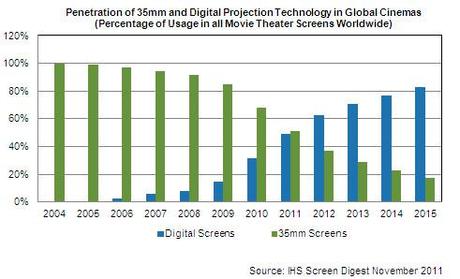When you think of the Digital Age and it's impact on our way of doing things the impact has been sudden and phenomenal to say the least. Social media empires like Facebook, Google and YouTube just to name a few have changed the way we do things. The digital impact has expanded even further defeating the 123 year old 35mm film in global cinemas. Some are calling it the death of 35mm film. The numbers are shown in the chart below.

http://www.isuppli.com/Media-Research/News/Pages/The-End-of-an-Era-Arrives-as-Digital-Technology-Displaces-35-mm-Film-in-Cinema-Projection.aspx
All of UK cinemas will be digital by 2013. In early 2012, digital cinema will overtake celluloid globally, with the last celluloid cinemas expected to shut up shop in 2015. The demand for celluloid peaked in 2008 when the world used 13 billion feet of film, says IHS. IHS believes we will use as little as four billion in 2012. By 2015, the film will no longer be used commercially, however they will still have libraries that store the old celluloid releases. Directors may still use the format to shoot films, then they will be converted to digital to show on the digital projectors at cinemas. The motion picture industry is abandoning the photography and projection of its stories on 35mm celluloid in order to save money. Major camera companies aren't even making film cameras anymore, since filmmakers can shoot, edit, transport, and exhibit films entirely on digital equipment at a fraction of the cost of striking and shipping film prints. The cost of producing celluloid film is soaring due to rising prices for due to the silver, which is a key raw material used in creation.
The decline of 35mm is happening at astounding velocity, some trigger the transition to digital technology to one film, Avatar. "Since 1889, 35mm has been the principal film projection technology, taking movie audiences from the slapstick of the silent age, through the great musicals of the sound era, to the epoch of the summer blockbuster," said David Hancock, head of film and cinema research at IHS. The widely accepted and in depth 3-D technology that was used in this film that was released in December of 2009 helped to speed up thedeath of the 35mm. "Avatar's release was a pivotal moment for digital cinema, with digital technology forming the bedrock of modern cinema environment," Hancock said. Avatar alone has driven up demand for digital 3-D technology at the expense of traditional 35mm celluloid.
We are in the digital age that is forever changing to create new ways to give us content in various interesting methods. While the era of 35mm will end at this time, there will still be some older films circulating for some classic theaters. Even though the last prints will be quite pricey a small number of theaters will continue to show the 35mm to keep the legacy of traditional film alive.

